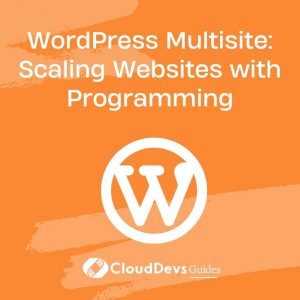WordPress Multisite: Scaling Websites with Programming
In the dynamic world of online business, a single website might not always be enough to meet your diverse needs. As your online presence grows, managing multiple websites can become overwhelming and time-consuming. This is where WordPress Multisite comes into play. It’s a powerful feature that allows you to manage multiple WordPress websites from a single installation. But managing multiple websites isn’t just about convenience – it’s also about scalability and performance. In this blog, we’ll explore how you can scale your websites using programming techniques within a WordPress Multisite network, ensuring that your digital empire thrives efficiently.
Table of Contents
1. Understanding WordPress Multisite
WordPress Multisite is a feature that enables you to create a network of interconnected websites, all running on a single WordPress installation. Each website within the network can have its own unique domain or subdomain. This is especially useful for organizations, agencies, or businesses that want to manage multiple websites while having a unified backend for administration.
2. Advantages of WordPress Multisite
- Centralized Management: With WordPress Multisite, you can manage all your websites from a single dashboard. This centralized approach simplifies updates, plugin installations, and user management, saving you a significant amount of time and effort.
- Cost Efficiency: Instead of setting up separate hosting and installations for each website, Multisite allows you to manage multiple websites under a single hosting account, reducing hosting costs.
- Consistent Design and Branding: You can maintain consistent branding across all your websites by sharing themes and design elements. This ensures a uniform user experience.
- Simplified User Management: Multisite offers granular control over user roles and permissions. You can manage users across all websites, ensuring that the right people have access to the right resources.
3. Scaling with Programming Techniques
While WordPress Multisite provides a strong foundation for managing multiple websites, there are programming techniques you can implement to enhance scalability, performance, and customization.
3.1. Content Distribution Networks (CDNs)
A CDN is a network of servers distributed geographically that work together to deliver web content to users based on their location. By integrating a CDN into your WordPress Multisite network, you can significantly improve the speed and delivery of your websites. Here’s an example of how you can configure a CDN using a popular service like Cloudflare:
php
// functions.php within your theme
function setup_cdn() {
if (function_exists('cdn_url')) {
$cdn_url = cdn_url();
// Replace 'example.com' with your actual CDN domain
wp_enqueue_style('style', $cdn_url . '/style.css', array(), null);
wp_enqueue_script('script', $cdn_url . '/script.js', array(), null, true);
}
}
add_action('wp_enqueue_scripts', 'setup_cdn');
3.2. Caching and Object Caching
Caching is crucial for optimizing website performance. By storing frequently accessed data in a cache, you reduce the load on your server and provide faster access to users. Additionally, implementing object caching can further enhance performance by storing database queries and processed data in memory. Consider using a caching plugin like W3 Total Cache or WP Super Cache and integrating an object caching mechanism like Redis.
php
// wp-config.php
define('WP_CACHE', true);
define('WP_CACHE_KEY_SALT', 'your_unique_salt_here');
define('WP_REDIS_HOST', '127.0.0.1');
define('WP_REDIS_PORT', 6379);
3.3. Custom Plugins for Multisite Functionality
Sometimes, the built-in features of WordPress Multisite might not cover all your requirements. This is where custom plugins come in. You can develop plugins tailored to your Multisite network, adding features, functionalities, and optimizations specific to your websites. Let’s say you want to implement a custom user role for network administrators:
php
// Custom plugin for adding a network admin role
function add_network_admin_role() {
add_role('network_admin', 'Network Administrator', array(
'read' => true,
'manage_network' => true,
'manage_sites' => true,
// Add more capabilities as needed
));
}
add_action('init', 'add_network_admin_role');
3.4. Load Balancing for High Traffic
If your network experiences high traffic, implementing load balancing can distribute the workload across multiple servers, preventing server overload. This can be achieved by using server software like Nginx or using managed hosting services that offer load balancing configurations.
nginx
# Nginx configuration for load balancing
upstream backend {
server backend1.example.com;
server backend2.example.com;
# Add more servers as needed
}
server {
location / {
proxy_pass http://backend;
}
}
Conclusion
Scaling your WordPress websites within a Multisite network is not just about managing more websites; it’s about optimizing performance, enhancing user experience, and maximizing efficiency. By implementing programming techniques like CDNs, caching, custom plugins, and load balancing, you can ensure that your websites not only survive but thrive in the competitive online landscape. With the power of WordPress Multisite and strategic programming, you have the tools to create a network of websites that scales gracefully while providing exceptional user experiences.
Remember, as your network evolves, staying up-to-date with the latest programming practices and WordPress updates is essential. By continuously refining your techniques, you can keep your Multisite network at the forefront of performance and innovation.
So, whether you’re a business expanding its digital presence or a creative agency managing client websites, harness the power of WordPress Multisite and programming to take your websites to new heights of success.
Table of Contents








